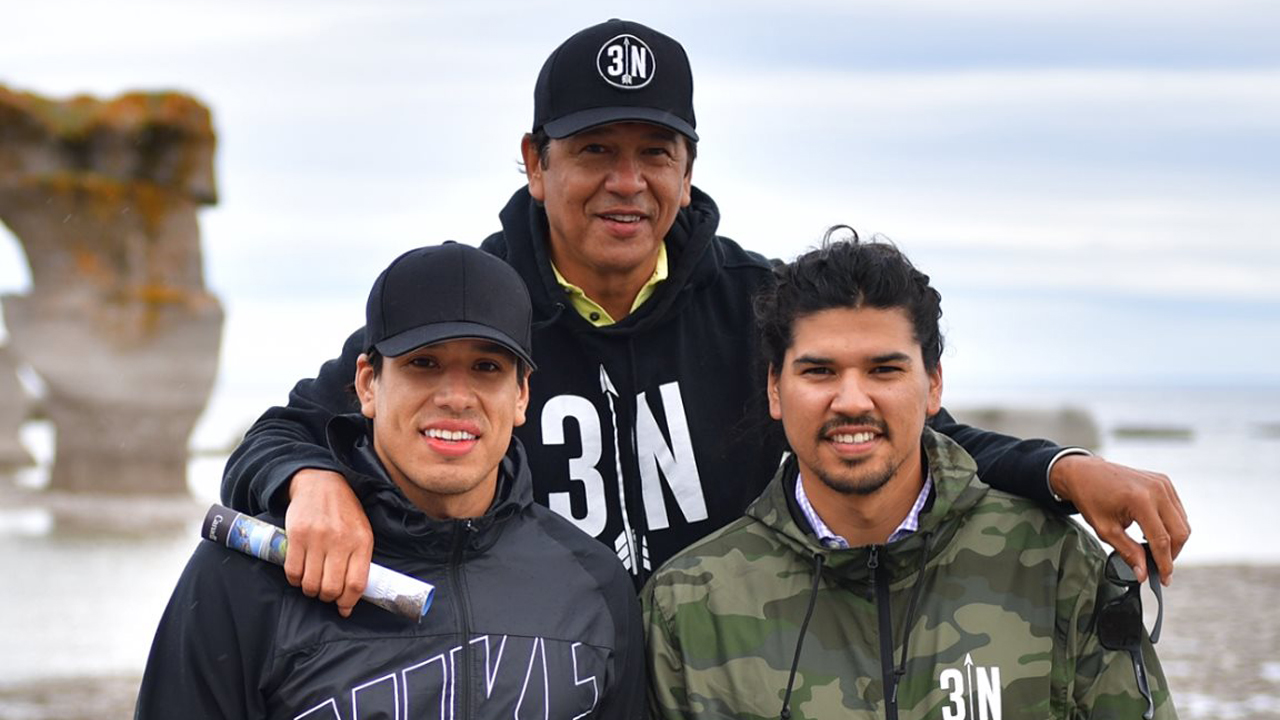
“BEAUTIFUL, NEEDED AND IMPORTANT AS ALL HELL”
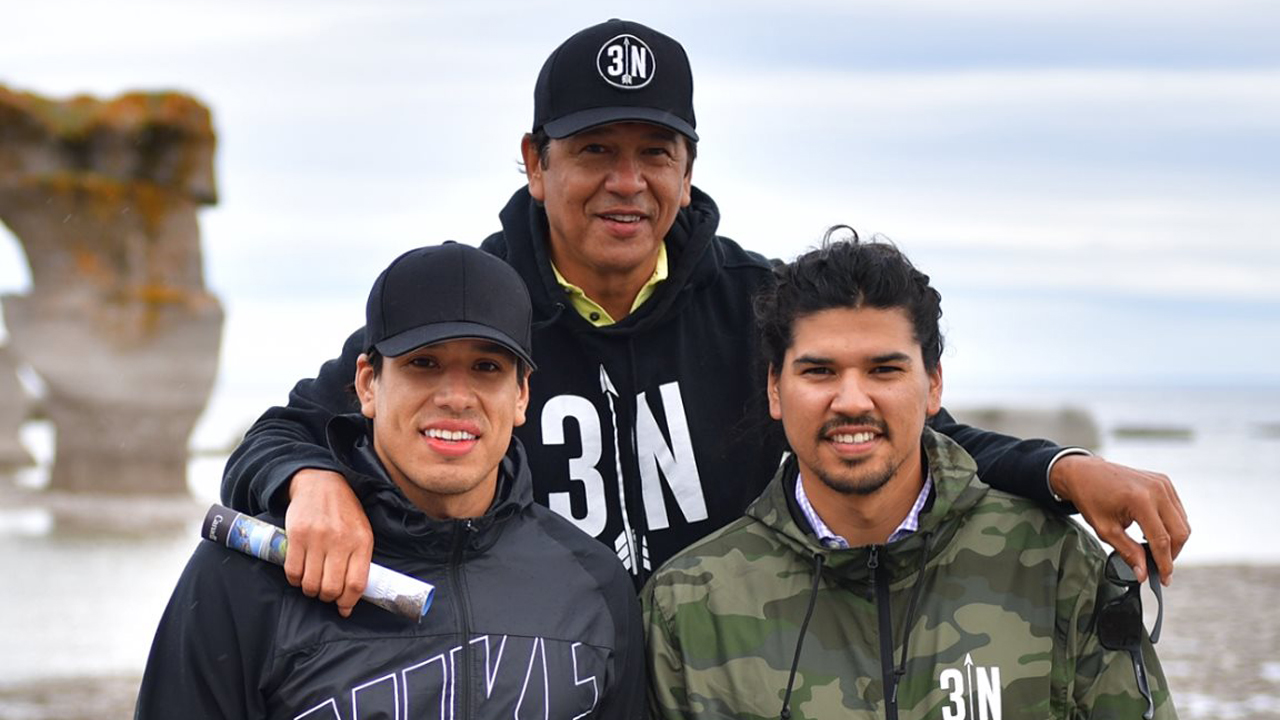
T
here’s a rail bridge that sits atop a pillar of stone in Garden River First Nation, a band of black and brown metal that emerges from lush trees on one side of the water and escapes back into them on the other. On the side of the bridge facing the nearby highway, scrawled in towering, six-foot-tall letters in white spray-paint that still appears frozen in mid-drip all these years later, are four words: “This is Indian land.”
Rick Nolan wrote that declaration decades ago. In 2012, when Rick’s nephew Jordan returned home with the Stanley Cup, bringing a day of celebration to Garden River, it was on that bridge that the most triumphant moment of the celebration came. Draped in his black Los Angeles Kings jersey, a grey ballcap pulled over his head, Jordan strolled out onto the bridge with the trophy and took up a spot above the centre of the third word. Family, friends and neighbours gathered to take in the sight from the highway, lining the railing. Some sat on shoulders or perched on concrete barriers to get a better look; others watched from the banks below or from small boats bobbing in the water.
A grin spreading wide across his face, Jordan took the Cup in both hands and raised it to the sky. The crowd across the water erupted, voices and applause jostling to ring out loudest. They grew even louder still a minute later, when Jordan’s brother, Brandon, and father, Ted, joined him, the three Nolans together lifting hockey’s biggest prize high above those four words.
To understand the true weight of that moment, you have to trace the Nolan family’s story back to a time before that paint met that metal. From a father who set this journey in motion, with a meteoric rise marred by betrayal; to an older brother who carved out a hard-fought path, only to see it cut short too soon; to a younger brother who followed that well-worn trail of footsteps to etch the family name in history.
The Nolans have endured enough valleys and peaks in the game to rival the topography of their beloved Garden River. Following that day of Stanley Cup triumph, it would’ve been easy to walk away, to put it all behind them. But like the one who wrote the message on that bridge, they refuse to stop fighting for their community. And after giving all they had to find greatness, after achieving it, these three Nolans found their true calling — sharing their stories with Indigenous youth, bringing their people together, and dedicating themselves to leading the next generation of leaders.
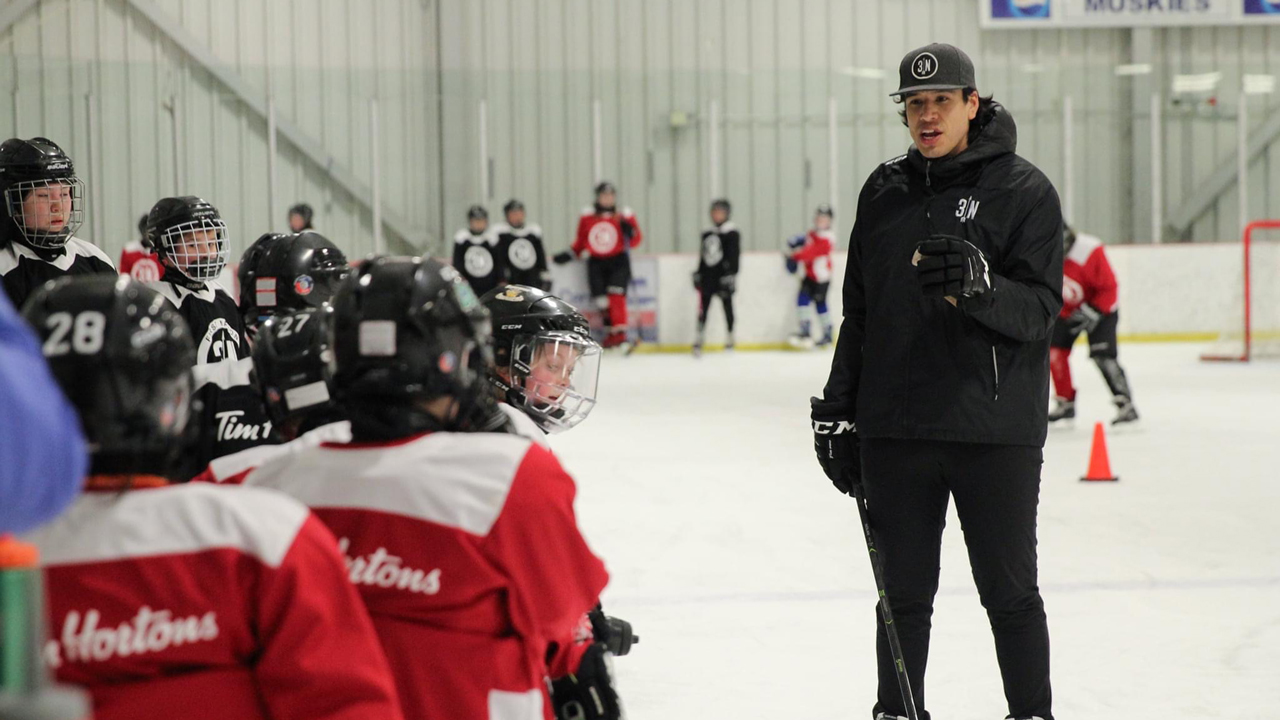
T
he message on that bridge is far from the only lasting mark Rick Nolan made on his community. It was the way he marked up the ice that first showed a young Ted the beauty of the game. “I fell in love with hockey just by watching the people in the community,” Ted says, “especially my older brother Rick — he played on a senior hockey team on the reserve, on the outdoor rinks.”
The third-youngest of Stan and Rose’s 12 children, Ted took that love and ran with it, searching out any possible way to play, even if it meant putting in hours and hours just for a single stride across the sheet. “My story began with one pail of water at a time,” he says. “I made my own rink in the backyard in Garden River, from the outdoor pump. … I really played just for the pure enjoyment of the game. I just loved the whole concept, the magnitude of it. That you could pass, you can get the return pass, you can try to beat someone, you can try to score a goal — all those magical things on an outdoor rink with the moon shining brightly.
“Not ever once in my life did I ever think, ‘Jeez, if I work really hard, I could play in the National Hockey League.’ Because the National Hockey League, at my time, was like two worlds away.”
Ted’s world back then was a humble but loving one, surrounded by family, surrounded by the game. “We didn’t have electricity for a little while, we had outdoor plumbing — you know, times were lean,” Ted remembers. “We didn’t have money to join the city leagues.” It wasn’t until he was 10 years old, in the late 1960s, that he first joined a rec league in nearby Sault Ste. Marie, Ont. Seven years after that first foray, he ventured to Kenora, Ont. to play for the Manitoba Junior Hockey League’s Thistles. And it was there that a 17-year-old Ted first got a taste of what hockey really looked like outside of his community.
“That’s where the game of hockey really switched for me,” he says. “It switched drastically when I went there. Because then all of a sudden I faced bigotry. I faced name-calling, I faced racial abuse, bullying at school, all those type of things that basically took the love of the game away from me. It turned from love to trying to survive. Just trying to survive in the game.” The darkness that enveloped him in Kenora was only compounded by the darkness back home. “My father passed away that year when I went to Kenora. And I’m more than positive, if he was there, we wouldn’t be having this conversation,” Ted says. “Because I don’t think my father would have allowed me to go through what I went through.”
Ted refused to be driven out. Instead, he drew on what his parents taught him, on the lessons learned in Garden River. “The one thing they really instilled in us was, ‘Be proud of who you are.’ They always told us the stories, the legends, the ceremonies that we had. The pow wow, the medicine people that we have in our community, all the rich cultural things of being a First Nation person. I think that’s the stuff that really helped me,” he says. “Because some of the people who went before me, they couldn’t quite handle the outside, because of all those things. I just really wanted to prove that we can.”
He dug in, finding any way to make a life in the game work, just like he did years earlier with that water pail. “I was so stubborn by then, and bullheaded, that I wasn’t going to let anybody chase me home,” he says. “If they were going to chase me home, it was going to be because I wasn’t good enough. Not because they bullied me.”
As it turned out, he was more than good enough. A season later, Ted suited up for the Ontario Hockey League’s Soo Greyhounds, earning his spot by way of the impressive numbers he put up in Kenora. By the time he was 20, he was leaving the OHL to play pro, first for the Central Hockey League’s Kansas City Red Wings — at the time, the top farm team for the NHL’s Detroit Red Wings — then for the AHL’s Adirondack Red Wings, when the big club’s affiliation moved. Just a couple years into his time there, he was a champion, his AHL squad clinching the Calder Cup in ’81.
But as the on-ice success kept coming, the off-ice heartbreak did, too. That same year, his mother Rose was killed by a drunk driver. Looking back on those years now — all those battles, one cascading into another — it’s all a blur, Ted says. And the whirlwind only continued — the very next year, he was on the move again, called up for his first NHL game to help the big-city Red Wings take on Chicago. It should’ve been a moment of triumph. But by that point, all the loss and abuse he’d endured to get there, to simply exist in the game, was all almost too much to bear.
“When I played that first game in the National Hockey League, when I was 23 years of age, I remember laying tobacco outside of the Chicago stadium… and I had tears coming down my eyes,” he says. “It wasn’t the tears of, ‘Boy, I played in the National Hockey League.’ It was a tear for all the people who tried before me, tried different occupations, but for various different reasons couldn’t handle that. I mean, who could? I can’t believe I did.”
It took another half-decade of AHL campaigns, of stints with Detroit, and later the Pittsburgh Penguins, before Ted found relief from that seemingly unending battle, when two ruptured discs in his lower back ended his playing career. “I think I was happier that day than I was my first day I signed the NHL contract,” he says. “I was just so happy I didn’t have to go through that anymore, to constantly prove that I could.”
He decided it was time to move on from the sport. He went back to school, enrolling at Lake Superior State University in northern Michigan just across the border from home. He had his eyes on making a new life in the business world. But that love of the game pulled him back, just a little bit. He started helping out with practices for the school’s hockey team, just here and there. Before he knew it, word had made it across the river, and Phil Esposito, then-owner of the Soo Greyhounds, called Ted with an offer to help coach his former OHL club. “That was the first time anybody ever asked me to be part of a team,” Ted says. “So, I accepted. Long story short, three months later, they fired the head coach.
“And here I was, thrown right back in.”
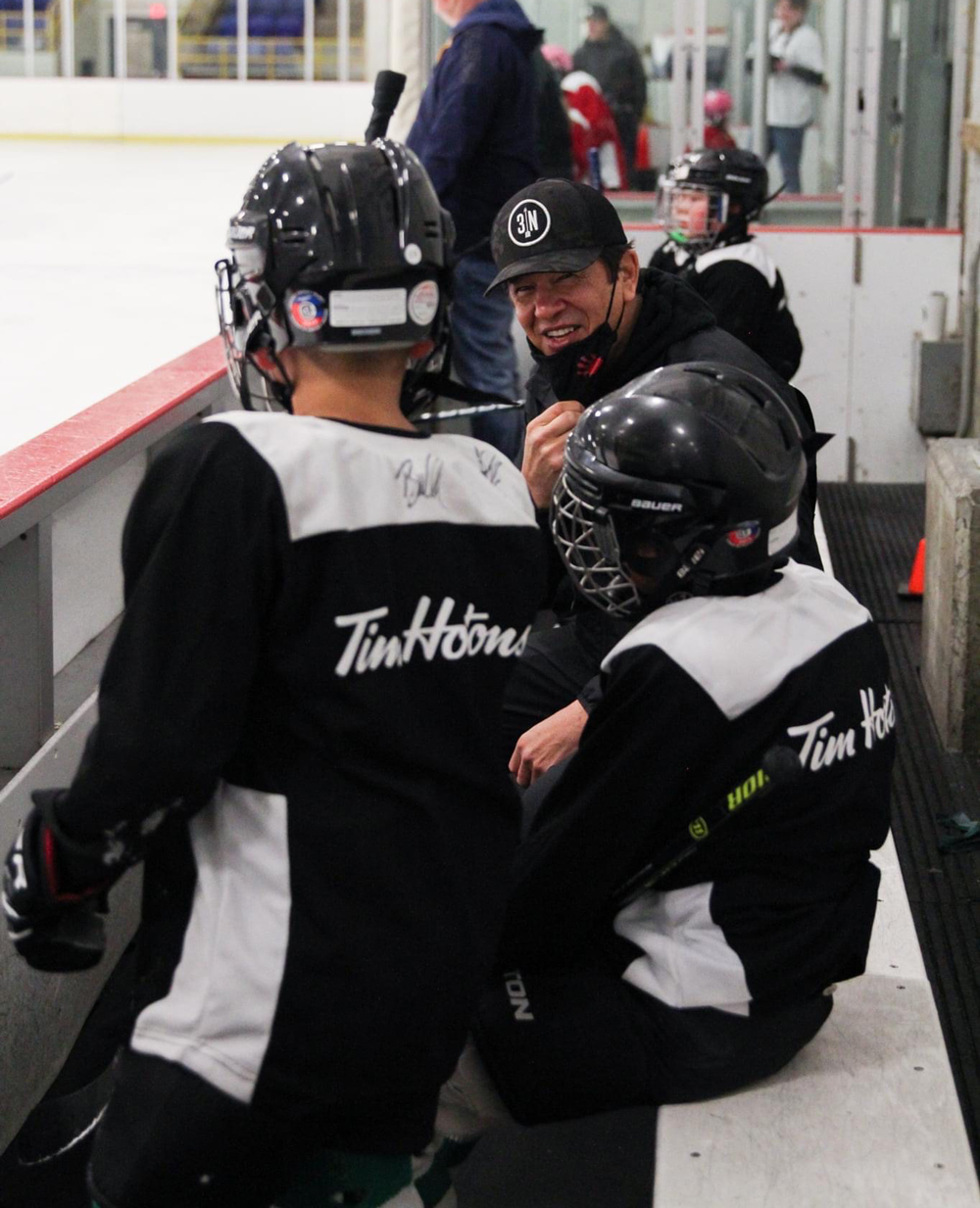
B
randon Nolan fell in love with the game much the same way his father did, out on the backyard ice in Garden River. But by the time Ted and Sandra’s eldest was taking his first spin on the sheet, the water pail was long retired. In its place, Ted built for his sons what he’d dreamed of when he first laced up his skates. “It was just an amazing rink,” Brandon says. “It had boards; it had lights. It was a place that we could play all day and night if we wanted to. And most often we did.”
It wasn’t just for the Nolan boys. It was for any kid in Garden River who felt that same gravitational pull from sticks, pucks and a clean sheet of ice. “It was kind of like the community hangout,” Brandon says. “On nights or weekends, all ages would come. I was a little bit younger, I was probably eight, nine, in around that age, and I just remember kids from six years old to 14, 15, all coming to our backyard to play.”
Thinking back on how he first developed an affinity for the sport, one other thing stands out in Brandon’s mind: the nights spent watching his dad behind the Greyhounds bench. “I got a chance to go to a lot of games,” he says. “I got a chance to go to practices. I got a chance to hang out in the dressing room.” He got a chance to see his dad lead the Greyhounds on a dynastic run through the junior hockey gauntlet, taking the team to the Memorial Cup tournament three straight years. And finally, in ’93, with Sault Ste. Marie hosting the event, he got to see his dad’s side win it all. “It was just absolutely amazing. I thought they were the best team in the world,” Brandon says.
It didn’t come as easy as it might’ve looked to nine-year-old Brandon, cheering on his dad from beyond the glass. Ted’s first year coaching his former club was soundtracked by boos raining down from the stands, the team struggling as its new coach learned the ropes. But just like his days on the ice, Ted refused to be chased out. “That stubborn bone inside me again said, ‘I got to learn. I got to learn how to be a coach,’” he remembers. “I went out and studied. I studied Phil Jackson. I watched the [‘70s era] Philadelphia Flyers, with Fred Shero coaching, found out what he does. I talked to a number of coaches. And I brought some Native spirituality to my coaching. And lo and behold, the next season, we won the league championship.”
Above all else, his approach to coaching was led by one guiding principle. “I coached the way I wished people would’ve coached me,” Ted says. “I really wanted to make a difference with people that I coached. So I talked to people a lot, I talked to the players — ‘How are you feeling? How’s the family?’ … I just loved it. I probably loved coaching more than I loved playing.”
Soon, NHL executives were taking notice. Brandon watched his dad move from the Soo’s bench to the Hartford Whalers as an assistant coach, then to the Buffalo Sabres, where Ted earned his first shot at being an NHL head coach. He watched his dad lead the Sabres to a division title in his second year, watched him win the ’97 Jack Adams Award as the best bench boss in the game.
But again, it wasn’t as rosy as it all looked on the other side of the glass. Behind the scenes, Ted’s relationship with Sabres management had splintered over the course of that season, due in part to his decision to keep the team’s star centreman, Pat LaFontaine, out of the lineup as he recovered from a concussion, Ted wanting to ensure the injury situation didn’t worsen. As tensions around the team swelled, rumours about its coach began to spread. “You can’t justify why the team wasn’t playing very well, you have to justify it some other way. So, what’s a better way than to pick on a Native guy and say he’s drinking all the time, he’s drunk at practice?” Ted says. “Give me a break.” Despite all he’d given to the game as a player, as a coach, the unfounded rumours persisted. “Then people start believing.”
As that Jack Adams moment arrived, he was already being pushed out of Buffalo, he says. “I was coaching the Buffalo Sabres, winning coach of the year, and all of a sudden, boom. It’s like somebody walked into the room and turned the lights off.”
Just one offer for the coach of the year came in. It was from an old friend, Esposito, offering up a chance to coach the Tampa Bay Lightning. “I didn’t take it, and only for one reason — it was because of my two boys,” Ted says. “At the time, the [youth]hockey program down in Florida wasn’t the best. And my oldest boy, he was an aspiring player. He wanted to play.”
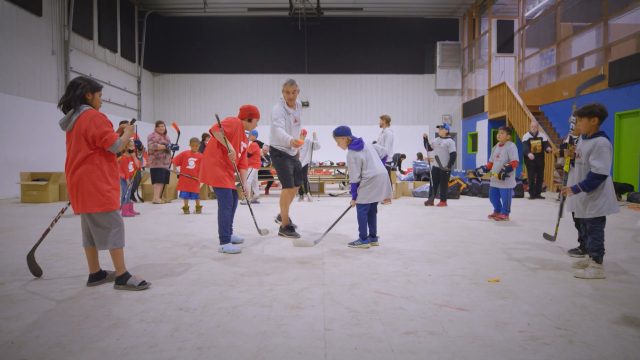
As Ted’s time in the hockey world went dark, the lights were switched on for Brandon’s. Just a couple years after that Sabres run came to an end, Ted’s son was heading south to begin his own trek towards the big leagues. But venturing out of Garden River — first to St. Catharines, Ont., and then to Oshawa — Brandon carried the lessons his father learned decades prior. “You learn the system a little bit, you learn what they’re looking for,” Ted says. “You learn you can’t be shy. I was the same way — they looked at me like I was shy, they’d think I didn’t care. It was totally different. It was just our upbringing, a way we are. When we speak to elders, we keep our head down. It’s not showing disrespect that you’re not looking at them. But they don’t know.
“So, when I got my two boys, I said, ‘Brandon, you go into the coach’s room — when he talks to you, you look at him in the eye.’ He said, ‘Well Dad, isn’t that showing disrespect?’ I said, ‘No, in their world, you have to do that. If you don’t, they think you don’t care.’”
There was something more foundational that Ted and Sandra passed down to Brandon, too. “In anything in life, whether it was hockey or school or really anything we were going to do, they taught us we had to work. We learned that at an early age,” Brandon says. So, when the young forward went on to play for the OHL’s Oshawa Generals and turned a solid rookie campaign into a point-a-game sophomore season, and then notched a dominant third year as the team’s leading goal-scorer, he kept his focus on another benchmark. “I just remember working, working all the time, working my absolute hardest.” After each home game, the team would give out awards: three stars, player of the game — and the team’s hardest worker. “It was always my goal to win that hardest worker award,” he says. “I obviously love hockey, but there was something about working hard and pushing yourself to the absolute max, the grind of hockey, which I really fell in love with.”
Despite the numbers, despite that grind mentality, the last stretch of his trek to the pro level had more starts and stops than expected. He heard his name called by the New Jersey Devils in the third round of the 2001 NHL Draft, but wound up without a contract. He got another shot two years later, when the Vancouver Canucks tabbed him in the fourth round in 2003. He went to camp with an eye on impressing then-GM Brian Burke, hoping history wouldn’t repeat. He did enough to earn an AHL contract with the Manitoba Moose, but the going didn’t get any easier from there. “First year pro, it was really tough,” he says. “I didn’t play much. I probably got two or three shifts a game. Coming from junior hockey, where you’re playing probably close to half the game … you’re leaned on for every opportunity and every stressful situation that your team was in. Going to pro hockey and being on the fourth line, getting told to just get the puck deep, bang a body, and get off the ice.”
Brandon was out of sorts in the limited role. Before that first year was up, Canucks brass demoted him to the ECHL. Ted told him to just keep pushing. “My father always said, ‘If it’s not working, you’re not working hard enough.’ So that was something I always had in the back of my mind,” Brandon remembers. But the hits just kept coming — when his three years with the Canucks organization were up, the club cut him loose. Without a contract, without much hope of being given a real shot in the AHL, he took a step back and took stock, eventually signing with the Vaxjo Lakers of Sweden’s second league. “I kind of gave up on my pro hockey in North America,” Brandon says, “on my dream of playing the NHL.”
Once again, as one’s path in the game darkened, the lights turned on for the other. Back home, Ted had stepped away from hockey, focusing his energy on his Ted Nolan Foundation, giving out scholarships to First Nation women in honour of his mother. But the game pulled him back yet again. The Moncton Wildcats came calling; by the end of the year, Ted had led them to a Quebec Major Junior Hockey League championship. Then it was the New York Islanders on the phone, and a decade after his time in Buffalo came to an end, Ted was back in the NHL, back in the head coach’s chair. It was a newly appointed senior advisor to Islanders owner Charles Wang who’d suggested Ted as the club’s new coach, someone who’d seen his work firsthand, someone who understood better than anyone just how dedicated he was to his players: Pat LaFontaine.
As Ted stepped back into the big leagues, Brandon rekindled his own NHL dream, signing with the AHL’s Bridgeport Sound Tigers. “I just remember coming back [to North America]and saying to myself, ‘I got to go all in here,’” Brandon remembers. “‘I’m 24 years old. I’m not going to get many more opportunities after this year. If I don’t play like I can, I’m probably going to have to retire.’” Leaving every bit of himself out on the sheet, he earned another AHL contract the next season, with the Albany River Rats. And there, something shifted. “I finally got my opportunity, and got a coach that believed in me, in Tom Rowe,” he says of Albany’s bench boss. “Someone who saw my potential. … I finally got that belief again.”
Given a shot to show what he could truly do, Brandon thrived. He got more ice, got a bigger role. And with the calendar about to flip to his fifth year as a pro, he got that call. “Everything happened so fast,” he says. “I just remember having dinner, getting ready for tomorrow’s practice, and getting a call from my coach Tom Rowe saying, ‘The Carolina Hurricanes are going to call you soon, and you’re going to go up to the NHL.’
“It was just really emotional. It was just an amazing time. Because I worked my whole life to attain that goal and dream of playing in the NHL.”
The next night, he was in a Hurricanes jersey for his big-league debut, lining up against the Tampa Bay Lightning, the same club has father had turned down in order to give him a chance at this very moment. Family and friends flew in. He slotted in on the third line, got eight minutes of ice, and tallied an assist on the Canes’ first goal of a 4-1 win. “It was absolutely amazing. It was like everything I dreamt of as a kid, just playing against the best players in the world,” he says. More than that, it was validation for all he’d poured into the journey to get there. “I’m definitely proud of the mental toughness I had to show,” he says. “Sometimes you’d definitely doubt yourself. You’d wonder if you’re good enough, if you’re ever going to get an opportunity. You know, ‘Maybe I’m just not skilled enough. Maybe I’m not big enough.’ All those things creep into your mind. … I’m just grateful for finding a coach that believed in me.”
Exactly two months later, after six NHL appearances, Brandon suffered a devastating concussion in an AHL game against his former team, Bridgeport.
“I was never able to play pro hockey again.”
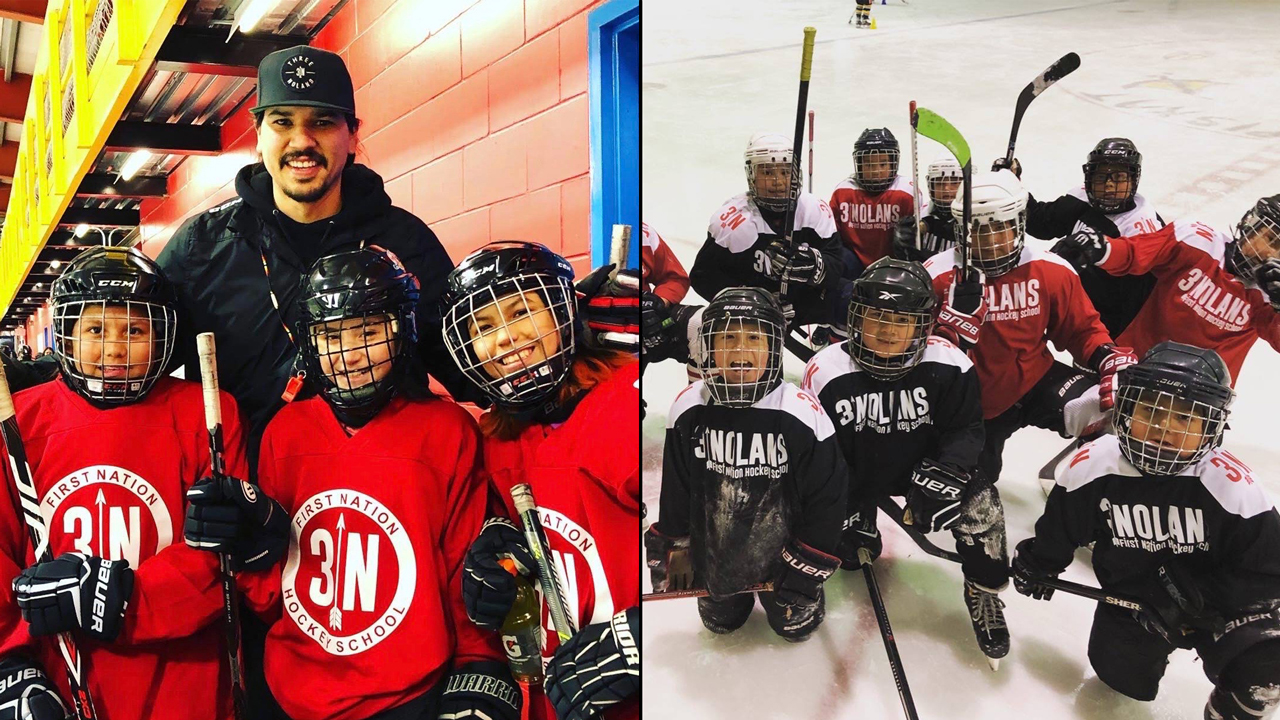
L
ike all the Nolans that came before him, the first seeds of Jordan’s love for the game were planted at home, in that backyard. “I just remember growing up in Garden River, my dad always making rinks, watering and packing down the snow with his feet,” he says. “Skating under the moon, some Christmas lights up on the back porch — I think that’s where I fell in love with the sport. Not so much competing, but really just skating outside and having that freedom.”
And just as Ted’s love for the game grew by watching Rick, just as Brandon’s had by watching his dad, for Jordan, it was watching his older brother out on the ice that helped his flourish. “My mom and dad, we would drive up pretty much every weekend to watch him play,” Jordan says. Whether it was St. Catharines, Oshawa, or any other city hosting his brother’s squad, more often than not, Jordan was there in the stands cheering him on. “One time we drove up to Sudbury, just a night there and back — it was about a six-hour drive from where we were.”
Though the game was in Jordan’s blood, the all-in mentality that drove his brother and father didn’t come naturally to him. “I was always a pretty laid-back kid,” he says. “It took me a while to kind of develop that intensity and that approach you need to take for the game when it does become serious.” The first wake-up call came on Day 1 of his Ontario Hockey League career, with the Erie Otters in 2005. “I showed up to [rookie]camp about 25 pounds overweight — and that wasn’t because I gained weight, it was just because that was the kind of kid I was,” he says with a chuckle. “You know, I had a stay-at-home mom who used to cook every dinner and bake me lots of treats. I never worked out before the OHL Draft.”
Following Ted and Brandon’s examples and advice, Jordan dropped 20 pounds over the next few months, making the Otters as an underager by the time the 2005-06 season rolled around. But life outside just didn’t stack up to life back home. “I definitely got a little homesick, so I came home after Christmas and played junior-B hockey in my hometown for the Falcons,” he says. “I just wanted to see my friends, my high school. For me, at that point in my life, I wasn’t really trying to make the NHL — I never even thought about that.”
He restarted his OHL career the next season, playing a couple years in Windsor. But it was in his fourth year of junior that he truly found his footing, when a trade sent him to a familiar club: the Soo Greyhounds. “I think I always knew I was a half-decent player. I think I always knew I would potentially be a pretty good pro player if I put in the time, changed my diet, maybe went to bed a little bit earlier on the weekend,” Jordan says. “But definitely my 19-year-old year, that was kind of an eye-opener for me. You know, I wasn’t drafted for two NHL Drafts. I was coming to the end of my OHL career. … I talked to my parents, talked to my brother, really just focused the whole summer on training, eating right, getting the proper rest. Just approaching the game as, ‘This is my last shot. This is my last opportunity to make that final push.’ … The L.A. Kings took me in the seventh round, and took a chance on me.”
Lights on here, lights off there. While Jordan was getting his first taste of big-league life, back home, Brandon was still struggling with his being taken away a year earlier. He endured severe concussion symptoms for two years after that final game. Making matters worse, he had to balance his recovery with figuring out his next steps. “It was definitely really tough,” he says. “Having to retire from the game I love at the age of 25. Not knowing what I was going to do with my life.” By 27, he had a young family to think about, a child to provide for. He took a retail job, just to keep busy. But he had visions of something greater.
Nearly the same age Ted had been when an injury ended his playing career, Brandon followed his dad’s footsteps once again, and went back to school. “I just realized I had to get educated,” he says. “Because I wanted something more with my life. I wanted to get an education. I wanted to do something. … I wanted to try and create something that was my own, or my family’s own.” He returned to Oshawa, signing up for Durham College’s business administration program. He moved on. “It was so hard and difficult, but to some degree it was kind of a blessing in disguise,” Brandon says. “Because it forced me to get out of the mindset of hockey, hockey, hockey, and look at the big picture of what I was going to do with my life.”
As Brandon was finding a new way forward, Jordan was working his own way up in Manchester, New Hampshire, suiting up for the Kings’ AHL affiliate. In February 2012, his own call came — although this one was routed through minor-league roommate, Dwight King. “Dwight got the call at about 6 a.m.,” Jordan remembers. “It was an off-day, so I was asleep in the next room, enjoying our day off. He came and knocked on my door, and he just told me that we both got called up, so we had to pack our bags.”
With suitcases hastily pieced back together, they met the Kings on the road. The next night, Jordan made his NHL debut at the Islanders’ Nassau Coliseum, where his dad had made his NHL return just a few years earlier. “My mother was there, my brother flew in for the game. It was a pretty surreal moment,” Jordan says. “Because I remember flying to Tampa to watch my brother’s first game, and [now]he was right there supporting me.”
Just four months later, after his 46th NHL game, Jordan was out on the ice at the Staples Center raising the Stanley Cup. “When I was younger, I never dreamed about lifting the Stanley Cup, or winning a championship,” he says. “I just loved playing the game. Loved hanging out with the guys, getting to know your teammates, and whatever came my way, I would deal with it. During that run, I was just living in the moment.”
After all his father had endured, after all his brother had gone through, the youngest of the Nolans, following the path they’d laid out, earned the experience his family had been chasing for decades: Not the Stanley Cup, but the chance to play for the pure, uninhibited love of the game, the love all three of them felt in their bones back in Garden River, bathed in moonlight on the backyard rink. “It was definitely special, having my parents there on the ice, after that long journey,” Jordan says.
A couple months later, he, Brandon and Ted were on that bridge, standing above Rick’s words, holding that trophy to the sky. “Bringing the Cup back to Garden River was definitely at the top of my list of things I wanted to do,” Jordan says. “Sharing it with the community that supported me and helped support my dad during his journey. We’ve always wanted to give back to Indigenous communities … the community that supported us our whole lives.”
That day of celebration wouldn’t be their last. Jordan earned two more days with the Cup, winning again with the Kings in 2014, and once more with the St. Louis Blues in 2019.
But where once it seemed the path for one of the Nolans dimmed as another lit, now the glow spilled over all three. Ted took a flyer on a plucky Latvian men’s national team, agreeing to sign on as head coach. He led the group all the way to the 2014 Olympic Games in Sochi, Russia, guiding his underdog squad to one of the wildest games of the tournament as they nearly took down the powerhouse Canadians in the quarter-finals. So impressive was his stint of international duty, it earned him a return to Buffalo’s bench as head coach of the Sabres, courtesy of a call from the team’s new president of hockey operations, LaFontaine.
And amid all that on-ice revelry, off the ice, Brandon — finishing his program at Durham College, racking up academic awards along the way — had a vision. He saw his next chapter, his family’s next chapter. The Nolans had begun getting invites to share their stories at hockey schools. They’d seen one or two Indigenous kids at those camps staring up at them with pride. Remembering what it felt like to be surrounded by his community in his younger days on the ice, Brandon went to Ted and Jordan with an idea. “I said, ‘Let’s create our own. Let’s get out into our communities. Let’s work with our Indigenous youth.’” With that, the 3Nolans First Nation Hockey School was born.
“By, and for, Indigenous people.”
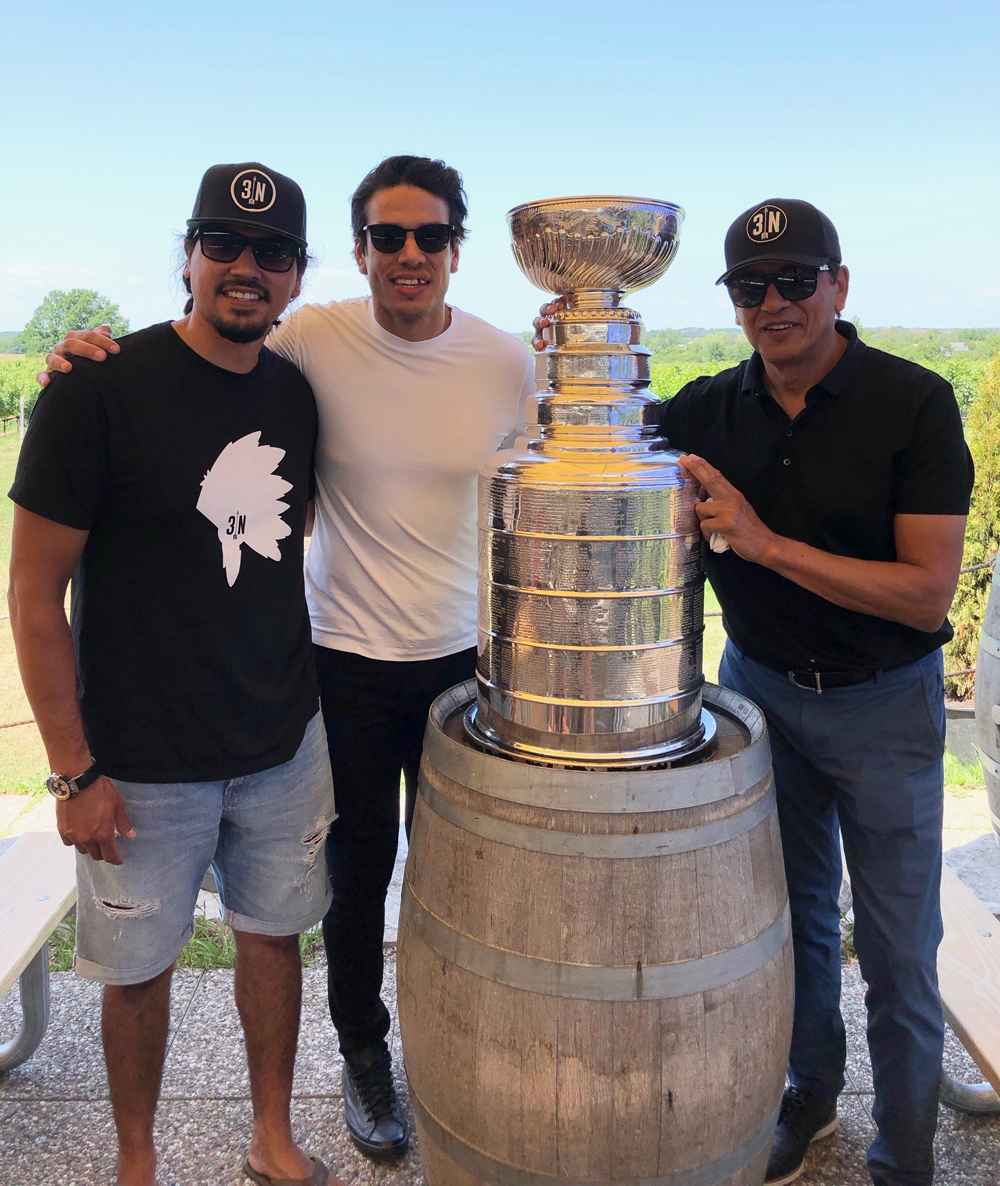
N
ine years on, that first spark has grown into something beautiful. Starting small, a couple hockey camps put together each summer, the Nolans are now running eight to 12 a year. It’s carried them through countless communities across the country, from Enoch Cree Nation, Ochapowace Nation, and Cross Lake First Nation in the west, to Couchiching First Nation, Kashechewan First Nation and Uashat mak Mani-Utenam in the east, with more than a dozen other stops in between. It’s put them on the ice with more then 3,000 kids in total, to share their stories and all they’ve learned.
It’s those lessons that remain the core of their work in each community they visit. While the kids get the chance to run drills with the former NHLers, while they get their own 3Nolans jersey and a day of scrimmages to show their stuff, there’s always one day set aside for a roundtable discussion. “Hockey is amazing, but at the end of the day, it’s a game. So, when we get to these communities, we do a lot of discussions on leadership, how to be a good person, how to give back to your community, how to be a leader in your community,” Brandon explains.
“We want to create leaders for our next generations,” adds Jordan. “We want our youth to know that you can really do anything that you want to do, but it does take hard work. … We’re not trying to create the next future NHL players. We’re just trying to create good people.”
Kieran Peltier helped organize the Nolans’ hockey camp in the North Bay Indigenous Hub earlier this year. The very first thing they created, he says, was a flurry of interest. “I threw that 3Nolans name on the poster and my phone didn’t stop ringing for two weeks,” he remembers with a laugh. More than 60 kids came out for the three-day camp, about three times the number Peltier usually sees for youth sports programs in the area. “What I really appreciated was how, just, real they were with everybody,” he says. “How they were just people, you know? There’s no looking down on people, there’s no ‘I’m better than you.’ They acted like that’s where they were meant to be. … And while they were out there, they didn’t hesitate to take time to just talk to a kid while they were skating by. In the beginning of practice, the pucks are on the ice, and they’re playing one-on-ones with kids, they’re doing one-timers with kids, they’re passing with kids, or they’re playing little games with the kids. I think that’s beautiful.”
BJ Fitzpatrick has helped organize three visits from the Nolans to Fort McKay First Nation over the years, going back to 2018. They get about 90 kids out to their sessions, so many they’re divided up into three age groups. “I always hear that it’s their favourite camp that comes up,” Fitzpatrick says of the kids. “A lot of times we don’t get the exposure to a lot of hockey camps in our little community of Fort McKay.” But the true gift isn’t just that hockey know-how, the on-ice instruction — it’s those stories. Those lessons learned from a long, winding journey. “It’s nice to see our kids gravitate towards other Indigenous people that are in that position, where they can share their knowledge and see their successes, and how they can translate that into their own lives,” Fitzpatrick says. “They can relate to the struggles that Brandon, Ted, and Jordan go through, just their different struggles throughout their careers. That carries a lot of weight when they come to these communities.”
When the camp in North Bay wrapped up, Peltier was flooded with messages from parents — thankful for what their kids got to experience, thankful for what they experienced themselves, wondering when they’d get the chance again. And it wasn’t simply because their kids’ slapshots improved. “A lot of people expressed their gratitude for the opportunity to participate, but not only that — to be connected to other Indigenous people,” Peltier says.
“Pride and belonging and identity is so important to us. It’s essential to our being. So, when we’re around our people, it’s healing.”
Making it all happen, keeping the program running, hasn’t been easy. “Financially it’s hard sometimes,” Ted says. “Even getting pucks to some of our communities because of the weight restrictions on airplanes, and some of the costs of flights to get into some of these communities, it’s quite costly.” But they make it work, the program kept afloat by donations, partnerships with other programs, and their own dedication. Sportsnet broadcaster and former NHLer, Anthony Stewart, has lent the support of his own program, Hockey Equality, to the family. In May, Hockey Equality sponsored a 3Nolans all-Indigenous U-15 team for the annual Bauer Spring Shootout tournament, bringing the kids to Toronto, setting them up with hotels, meals, tournament registration, and custom jerseys. It was a proud moment for the Nolans, their young squad making it to the tournament’s final. More than that, seeing that team out on the ice, it was a sign of just how far the program has come.
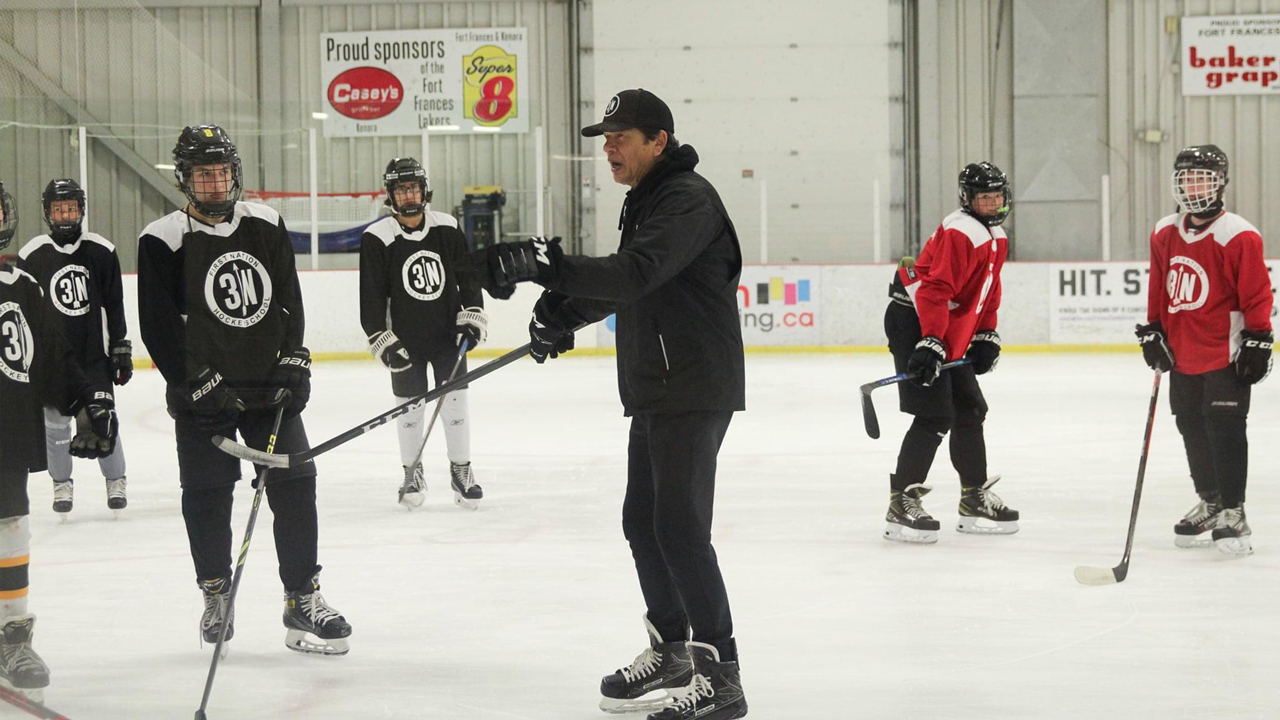
For Stewart, who’s worked with a number of different programs and organizers through Hockey Equality, it’s the Nolans’ limitless dedication that sets them apart. “It’s one thing just to talk about it, and maybe do it over Zoom, or send an email or a video,” he says. “But for them to travel on a plane, sometimes nine, 12 hours of traveling to get there, I think that really shows how important they are to the community.”
For the Nolans themselves, it’s all been worth it just to be part of the communities they’ve visited. “Our First Nation communities, they’re all over — some are close to major cities, some are fly-in communities, some we have to take five connecting flights to get there,” Brandon says. “So, we really get to experience so many different Indigenous communities. And once we get there, I mean, it feels like home.
“I would say 95 per cent of our hockey schools are all Indigenous, all First Nation. Sometimes we’ll go to a community and there’ll be non-Indigenous kids there, which is awesome because it gives those non-Indigenous kids an opportunity to be intermingled and to work with Indigenous kids that they may not know. It gives them an opportunity to work with our people, to create partnerships and to see we’re all just human beings, we’re all just playing the game that we love, and we need to all be respectful of everybody’s culture and upbringing.
“But when we get those chances to go to a place that’s all Indigenous and all First Nation, there’s just something about it that’s truly special. We’ll go some places and some people don’t even play hockey, they just want to be a part of the program. They want to be a part of getting together with all the other Indigenous youth.”
It’s the common thread that runs through each community they visit, adds Jordan, whether it has new facilities or old, 90 kids or 60 or even fewer. “What they all have similar is that they’re all excited for us to be there. They’re all excited to get out there and have some fun with their peers,” he says. “That’s really been the joy of it, watching all the First Nation youth get on the ice and really have some fun, and be free, and open up and tell us about the things that are going on in their life. That’s really the main thing for me, is just talking to these kids on a personal level, just getting to know them a little bit.”
For his father, it’s been watching that connection that’s meant the most — watching his boys. “Sometimes it brings tears to your eyes,” Ted says. “I’ll take a little bit of credit, but I’ll give the majority of the credit to their mom, Sandra, who did a tremendous job raising those two boys into young men. We didn’t want to raise jocks. We wanted to raise good gentlemen that knew how to care about people. And to see them doing what they do now, and how much passion they have for it, it sure makes a dad proud. More proud than watching Jordan win the Stanley Cup.
“That was a proud moment. But to watch him speak to a young group of First Nation kids? That’s way, way more powerful.”
Aside from the change they’re trying to make, the game they’re trying to grow, that’s the other reason the Nolans have come to relish these trips around the country. Life’s gotten busy. All three have moved on from their hockey careers, Ted working with the Chiefs of Ontario, Brandon running the 3Nolans program while raising three kids, Jordan raising two of his own while working on youth programs for the Kings and training to become a firefighter. While their work brings communities together, it brings them together, too. It brings their stories together, three paths now merged into one, like streams flowing into that river back home.
Where that path takes them, how their efforts and stories will be carried forward, remains to be seen. But those who’ve been there to see them work have no doubts about the effect they’re having. In Peltier’s eyes — his perspective shaped by his PhD research at Nipissing University, focused on improving the health of Indigenous youth through sport and physical activity — the impact of the Nolan family’s work reaches far beyond the ice: “The benefit of what they’re doing, it’s not only at a physical level, how it promotes health within the youth — but how it impacts their mental health, their emotional health, their spiritual health. How it impacts their connections to others, how it allows them to build confidence, to overcome barriers to sport, to physical activity, to education. How it impacts their identity, who they are, their sense of being, their ability to fit in and know themselves,” Peltier says.
“They’re providing that starting point. They’re the ignition to the fire. And I would even say they are the fire now, because they’re freaking burning, you know? They’re growing. They’re doing well. … They’re opening doors for those youth to pursue other opportunities, other experiences.
“Which is beautiful. It’s needed, and it’s important as all hell.”
Courtesy Brandon Nolan (7).







